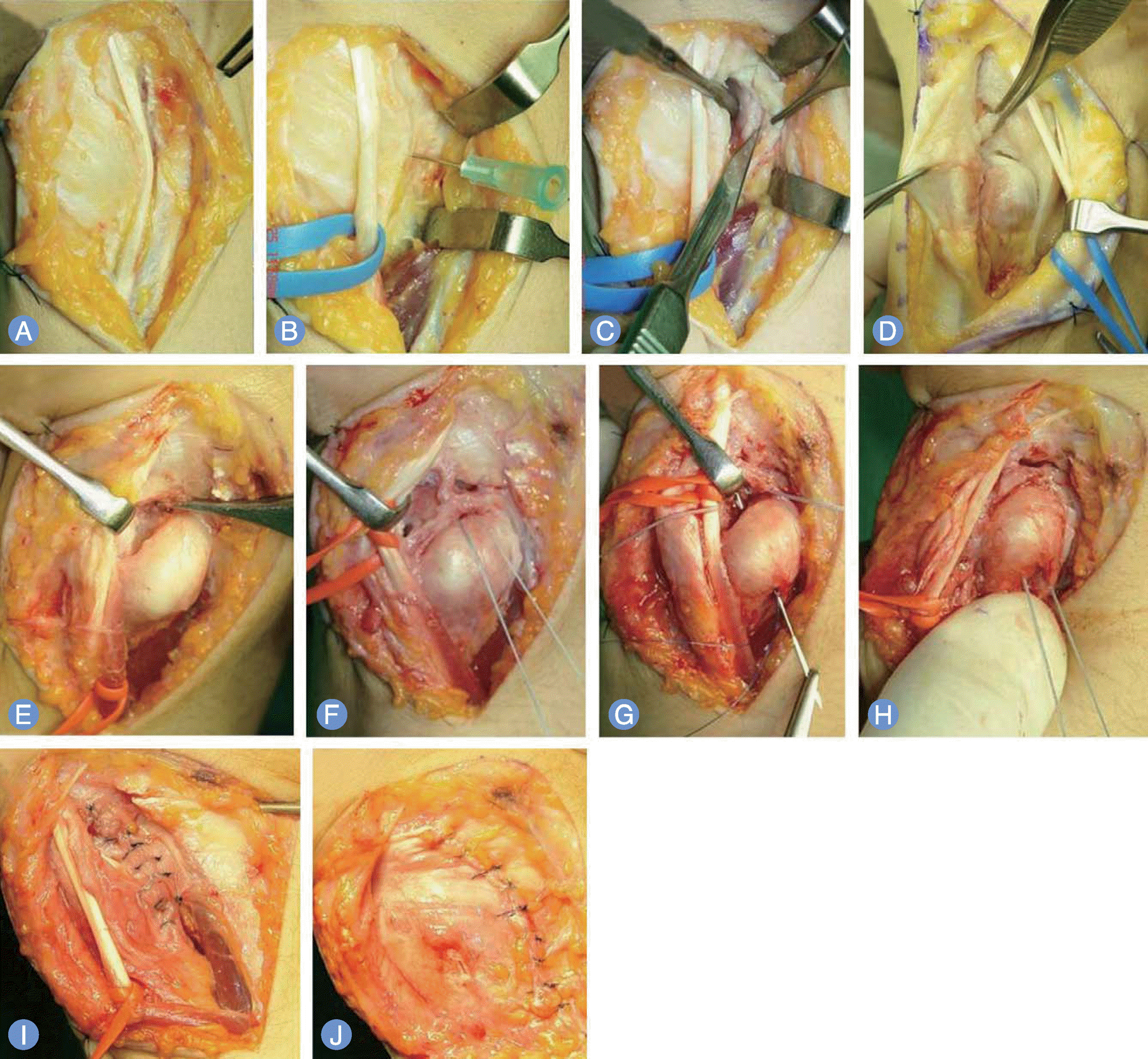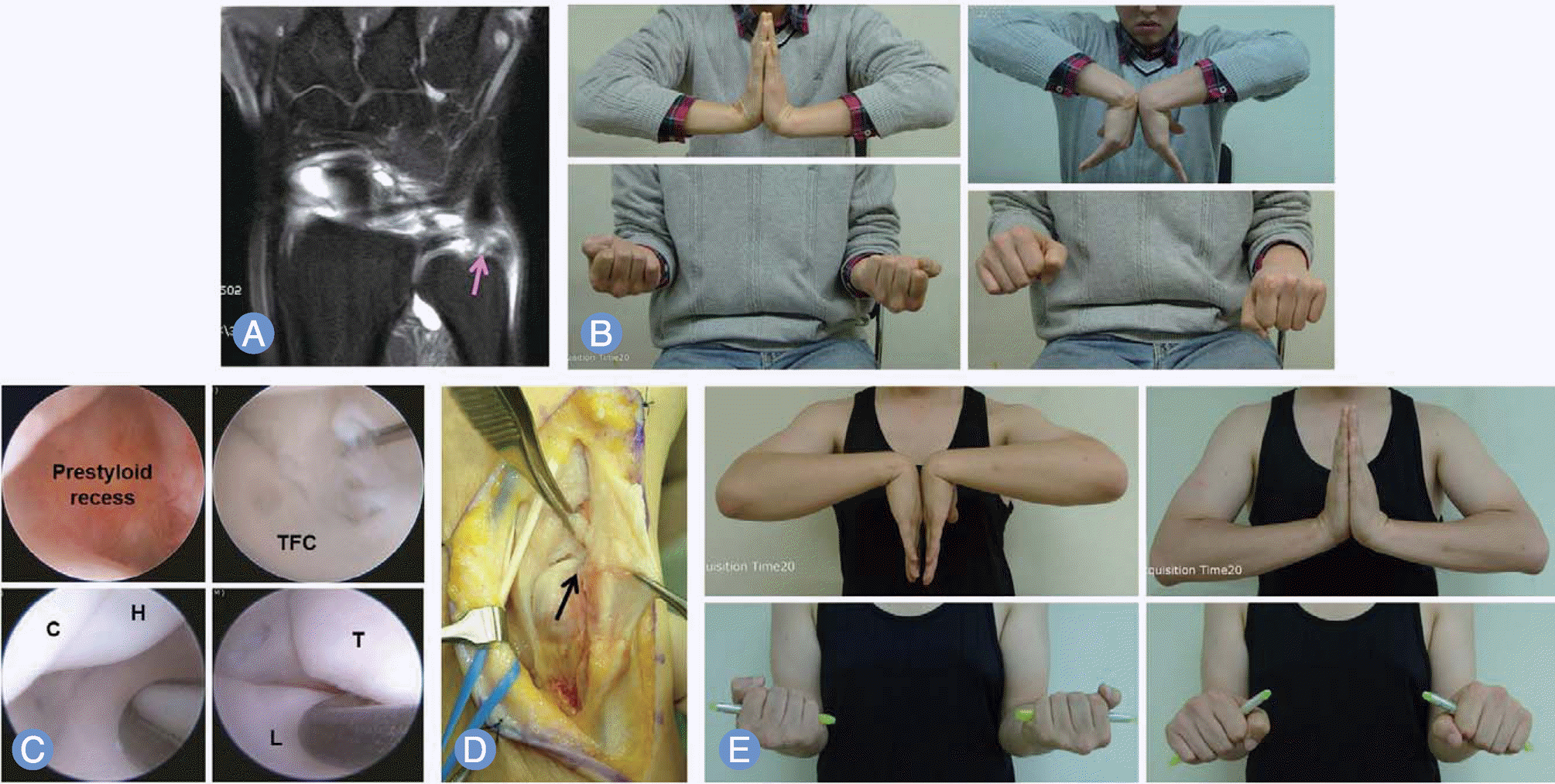Abstract
Purpose:
To investigate short term clinical outcomes of the open surgical repair for triangular fibrocartilage complex (TFCC) foveal detachment.
Methods:
We retrospectively reviewed 8 patients (5 men, 3 women) who had been treated with open surgical repair of the TFCC type 1B injury, from 2005 to 2013 and who were followed up for more than one year after surgery. Mean age at time of surgery was 34 years. The right side was involved in 3 patients, and the left in 5. The clinical results of surgery were assessed with modified Mayo wrist score (MMWS), disabilities of the arm, shoulder and hand (DASH) score and pain-visual analogue scale (VAS). Physical examination was performed to evaluate the prescence of distal radioulnar instability, preoperatively and at the latest follow-up.
Results:
The mean follow up period were 36.5 months (range, 12-64 months). The mean MMWS improved from 52.5 (range, 25-85) preoperatively to 82.5 (range, 75–100) postoperatively (p=0.02). The mean DASH score improved from 39.6 (range, 65-13.5) preoperatively to 13.4 (range, 2.5-33.3) postoperatively (p=0.012). The preoperative mean pain-VAS was 4.6 (range, 6-3); these value was reduced to mean 2 (range, 0-3) at the latest follow-up (p=0.016). There were no patients remaining instability after the surgery, although four patients showed distal radioulnar joint (DRUJ) instability before surgery.
Go to : 
REFERENCES
1. Millants P, De Smet L, Van Ransbeeck H. Outcome study of arthroscopic suturing of ulnar avulsions of the triangular fibrocartilage complex of the wrist. Chir Main. 2002; 21:298–300.

2. Lindau T, Adlercreutz C, Aspenberg P. Peripheral tears of the triangular fibrocartilage complex cause distal radioulnar joint instability after distal radial fractures. J Hand Surg Am. 2000; 25:464–8.

3. Iwasaki N, Minami A. Arthroscopically assisted reattachment of avulsed triangular fibrocartilage complex to the fovea of the ulnar head. J Hand Surg Am. 2009; 34:1323–6.

4. Atzei A, Rizzo A, Luchetti R, Fairplay T. Arthroscopic foveal repair of triangular fibrocartilage complex peripheral lesion with distal radioulnar joint instability. Tech Hand Up Extrem Surg. 2008; 12:226–35.

5. Haugstvedt JR, Berger RA, Nakamura T, Neale P, Berglund L, An KN. Relative contributions of the ulnar attachments of the triangular fibrocartilage complex to the dynamic stability of the distal radioulnar joint. J Hand Surg Am. 2006; 31:445–51.

6. Chou KH, Sarris IK, Sotereanos DG. Suture anchor repair of ulnar-sided triangular fibrocartilage complex tears. J Hand Surg Br. 2003; 28:546–50.

7. Sennwald GR, Lauterburg M, Zdravkovic V. A new technique of reattachment after traumatic avulsion of the TFCC at its ulnar insertion. J Hand Surg Br. 1995; 20:178–84.

8. Hermansdorfer JD, Kleinman WB. Management of chronic peripheral tears of the triangular fibrocartilage complex. J Hand Surg Am. 1991; 16:340–6.

9. Nakamura T, Sato K, Okazaki M, Toyama Y, Ikegami H. Repair of foveal detachment of the triangular fibrocartilage complex: open and arthroscopic transosseous techniques. Hand Clin. 2011; 27:281–90.

10. Nakamura T, Nakao Y, Ikegami H, Sato K, Takayama S. Open repair of the ulnar disruption of the triangular fibrocartilage complex with double three-dimensional mattress suturing technique. Tech Hand Up Extrem Surg. 2004; 8:116–23.

11. Cooney WP, Linscheid RL, Dobyns JH. Triangular fibrocartilage tears. J Hand Surg Am. 1994; 19:143–54.

12. Jester A, Harth A, Germann G. Measuring levels of upper-extremity disability in employed adults using the DASH Questionnaire. J Hand Surg Am. 2005; 30:1074.e1–e10.

13. Estrella EP, Hung LK, Ho PC, Tse WL. Arthroscopic repair of triangular fibrocartilage complex tears. Arthroscopy. 2007; 23:729–37.e1.

14. Hudak PL, Amadio PC, Bombardier C. Development of an upper extremity outcome measure: the DASH (disabilities of the arm, shoulder and hand) [corrected]. The Upper Extremity Collaborative Group (UECG). Am J Ind Med. 1996; 29:602–8.
15. SooHoo NF, McDonald AP, Seiler JG 3rdr, McGillivary GR. Evaluation of the construct validity of the DASH questionnaire by correlation to the SF-36. J Hand Surg Am. 2002; 27:537–41.

Go to : 
 | Fig. 1.
(A-J) Photographs showing the operative procedure of open repair for triangular fibrocartilage complex using dorsal approach. |
 | Fig. 2.Case of patient presenting with persisted ulnar side wrist pain after the initial injury 5 years ago. (A) The detachment of deep fiber of triangular fibrocartilage complex (TFCC) from the ulnar fovea (pink arrow) was observed in coronal view of magnetic resonance imaging scan. (B) Slight restriction of the pronation was observed. (C) During the arthroscopic examination, synovitis around the prestyloid recess was found with the loss of the tension of the TFCC (positive trampoline test) and traction induced inward folding of the TFCC from the ulnar fovea (positive hook test). Other combined injuries did not accompany. TFC, triangular fibrocartilage; C, capitate; H, hamate; L, lunate; T, triquetrum. (D) Open repair of the deep fiber of TFCC to the original ulnar fovea (black arrow) was done using the transosseous suture technique. (E) Five years after the surgery, functional outcomes measured by Mayo modified wrist score and disability of the arm, shoulder and arm score improved from 55 preoperatively to 100 postoperatively and 35 to 3.3, separately. |
Table 1.
Patients details
Table 2.
Clinical Outcomes of the open surgical repair for triangularfibrocartilage complex foveal detachment (type 1B injury)




 PDF
PDF ePub
ePub Citation
Citation Print
Print


 XML Download
XML Download